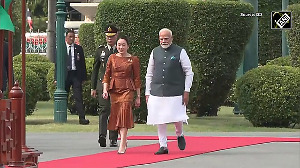In a bull market, the market ignores bad news. In a bear market, good news is ignored and bad news is highlighted. Here is some critical advice from technical analyst G Devanathan on how to stop losses, even before you trade.
Excerpts from an interview given to CNBC-TV18
What is the difference between trading and investing?
The difference is quite a bit. In fact, there is a complete difference in approach, in the parameter, in the holding period and in the expected return.
A fundamental investor likes to pick stock, based on value or growth and there are a lot of things, which he considers before investing in the scrip -- like management quality, return ratios, growth, margins, profitability, scalability or opportunity in the marketplace, etc.
The idea is to buy a stock at a price, which he feels the market will value much higher. The investment is made with the intention to hold it for a long period of time and he doesn't sell it so easily, as long as something has changed or the market overvalues it completely.
The expectation of the return also is much higher because he expects that eventually not only will he get a higher return to what other options are there in the country, but he hopes that his investment will give even a higher return than what the basic index, the Sensex or the Nifty would give. So that is the approach of a fundamental investor.
Trading is a bit more risky and it's largely short-term oriented and the approach is purely on a risk-reward basis -- to take advantage of the volatility in the market, to take advantage of the price movements in the market and his whole approach is that he has to make a profit in a short period of time. He hopes to buy with the intention that somebody will buy it from him at a higher price in the near future.
What are the different kinds of timeframes for trading?
Basically, from a trader's point of view you can classify timeframes in three manners. One, you have a typical intra-day trader, who makes up 80% of the volumes in the general market today and virtually any market in the world and then you have traders who generally hold a position between 1-5 days.
Generally, that position matures within a week's time. You can also have a core trader, who buys and holds a position for more than one week and it can go on as much as three months, on a predefined criterion that he is looking for.
What is swing trading?
Swing trading is where you try to buy during the quieter periods of the market. You try to buy during a reaction. You look at risk and supply more and you are able to define your risk very well.
It's a slightly complex exhibition strategy that realises on identification of market opportunities, primarily through charting the landscape. You buy in quieter times and sell during active times.
What kind of discipline do you need?
Swing basically is the hyperactivity of day-trading and the excitement of momentum trading as well. You basically observe the price behavior and look at supply. You don't look so much at demand.
You look at supports, you look at resistances where the price can stop, where you think accumulation is happening and you enter at such levels, where you feel you can define risk in a very correct manner. But a momentum trader has to be very fast. He doesn't have too much time to decide. Wherever the action is, he has to just jump in and go through with it.
Give us one typical example of an intra-day trade?
I think in the last few days there are three examples, which stand out, in which every intra-day trader in a country would have probably participated. We had three scrips, Titan, VSNL and SRF, which had wild movements over the last few days.
For two consecutive days, all these scrips ran up by Rs 50 per day. If you take Titan, which clocked it's life-time high volumes, the delivery volume was probably less than 3%-5% of the total volume.
Now volume was probably about 80-85 lakh (Rs 8-8.5 million) shares in the NSE but the delivery volume was less than 5 lakh (Rs 500,000) shares, so it shows that the entire balance quantity was purely intra-day trading activity. People who like action chase price movements.
What is core trading? Give us one example.
Core trading is generally done by people who are more experienced. They are people who are more aware of what's happening in the market and they track companies. You may do core trading on a scrip like Pantaloon on the expectation that in the next three months, they are going to open 2-3 new more stores.
So you want to buy now with the hope that the price will get higher, when those stores are open or you buy Tisco now with the hope that when the results are announced, it will surprise the market in a positive manner.
Can you stay out of markets and do core trading?
I think that is the best way, in fact, for new people who are coming into trading, it is better to come from a larger timeframe to a shorter timeframe. Whereas, most new people who come in, they all want intra-day action because there is temptation to make that overnight killing in the market.
So you are marrying fundamentals with technicals?
Yes and you hope that over a period of next one week to three months, positive news flow will drive the stock higher.
How does one go about choosing a timeframe?
The timeframe is basically the holding period of a position. So I think one has to chose the position based on one's lifestyle and on temperament. You have to choose your timeframe wisely and for the right reasons. Now if you are an intra-day trader, it needs a tremendous amount of concentration and focus to be there.
You see people trading in a very casual manner, they are busy with some other profession and they trade on the phone. So those kinds of things simply are not going to work in the long term. It may work for a few days, when the markets are very good. You have to pick a trading timeframe, which suits you.
What is the trend following system all about?
The trend following system is very interesting. It's widely prevalent in the West. It's a simple, at the same time a sophisticated form of trading, where the whole objective of a trend follower, is that he's willing to take small losses but his objective is not to miss any major trend in the market.
It's basically a mechanical system. It's a programme driven thing, where the computer tells you when to buy and when to sell, after you have defined the parameters. Your work is in purely defining the parameters, where you look at anything that you want to, in terms of risk, time and other things.
For example, a simple moving average crossover could be a trend following system and then what it does is, it goes back 5-10 years and tests available data and sees what kind of results this system would have produced, had it been followed for the past five years.
After fine-tuning it eventually, you settle on a particular trend and then you don't try to second guess the system, you just follow it. You buy when the computer tells you to buy, you sell when the computer tells you to sell.
How do you define the risk-reward concept?
This is the most important thing for a trader. Every time I trade, I know that it is not possible for me to get all my trades right, several could be wrong. So, my intention is that over a period of time or a bunch of trades, I end up making money.
Let me give you an example, suppose your stock price is Rs 100 and I am going to buy this share, now if I define my risk, say my risk is Rs 5, so I know that if the price goes to Rs 95, then I will be out of the Street but when I look at the Rs 5 risk, I would like to have a reward which is much higher than Rs 5.
In fact, I would like to look only for those situations where the potential reward is much higher than the risk. I would expect that the share goes at, at least Rs 210-215. So that gives me a 1:2 or 1:3 risk rewards. The reward being 2 or 3 times higher than the risk, the whole idea behind it is that I can afford to be wrong a few times, so that when I am right I make a larger amount of money.
What is stop-loss and trailing stop-loss?
Successful traders worldwide have a tremendous amount of risk. So after initiating the trade, if the stock doesn't move as you expect and once it comes to the cut-off point, where you have mentally decided that its not working out, you have to use it as stop loss. Like if it hits Rs 95, I am out of the Street no matter what.
Trailing stop-loss, is when the trade becomes successful and say in our example of Rs 95 as a stop loss, say the trade has become successful and the price has gone to Rs 110-115. At that time, I don't keep my stop loss at Rs 95, I move it up to Rs 100, or if the price has gone to Rs 115, I take my stop-loss to be Rs 108-109.
The whole idea is not to give back the profit that has come in and then say if the price goes to Rs 125 I may move my stop loss to Rs 120, and on its way down, if it comes to Rs 120, I will sell. So by keeping the trailing stop-loss, I am always going to book profits.
What is the importance of pyramiding and trade size in your strategy?
Pyramiding is essentially done by professional, season traders and also by people who trade in large sizes. Pyramiding is increasing your position once it becomes successful. Once you've made a profit, you actually increase your position and add to it because you expect to follow the trend and it will give you higher rewards.
But if as a large trader, you want to buy 1-2 lakh (Rs 100,000-200,000) share, it's not the right way to buy everything in one go because then what may happen is, you may get stopped out and you will probably lose money on the entire quantity.
So the idea is to take an initial position and see whether it's going in your favor and then as it goes in your favor, you may get more comfortable with the trade and then you may want to add to that position, or you may not want to add. So adding to a winning position is called pyramiding.
What is trade size?
Trade size is how much quantity you do in each trade. People do it in round figures. A person may buy 500 shares or 5000 shares, even if it is Rs 100 share, he buy 500 shares, and even if the price of the another scrip is Rs 180, he still buys 500.
But the idea is not to do it. The best way to do it is in a defined manner. How do you define it? It's based on the amount of money that you are willing to risk. Ideally, a trader should not lose more than 2-3% in a single trade.
Suppose I have got capital of Rs 1 lakh, in a single trade, I wouldn't want to lose more than 2%-3% of my total capital because I know that since I am going to be wrong a few times, I need the balance capital to get it right. So having determined the amount of loss that I am willing to take in a single trade and knowing my stop-loss, gives me the quantity.
Suppose, I am willing to risk Rs 5,000 in a particular trade and my stop-loss is Rs 5, then I will buy 1,000 shares. So if I am wrong, I know I am going to lose Rs 5,000. Doing the random quantity doesn't help because then if it becomes a losing trade, the loss could be much higher than what you had originally imagined it would be.
Tell us something about entry-exit strategies.
Entry and exit strategy is the basis on which you buy and sell. Now these are strategies, which each person has to develop on his own. These are strategies, which you adopt on your own.
An exit strategy is a very similar thing -- many things can be learnt by observing the market. You see in a bull market, the market ignores bad news. In a bear market, good news is ignored and bad news is highlighted and during a correction phase, you find that some stocks are holding out much better than the indices and other stocks. So those stocks are likely to be buy candidates, the next time the market goes up.
As a trader, one should not worry as to what the markets are doing. People all the time think about what the market is going to do. The best is what are you going to do in response to the market movement. So that is best to way to define your exit and entry strategy.
For more tips on investing better log on to www.moneycontrol.com







 © 2025
© 2025